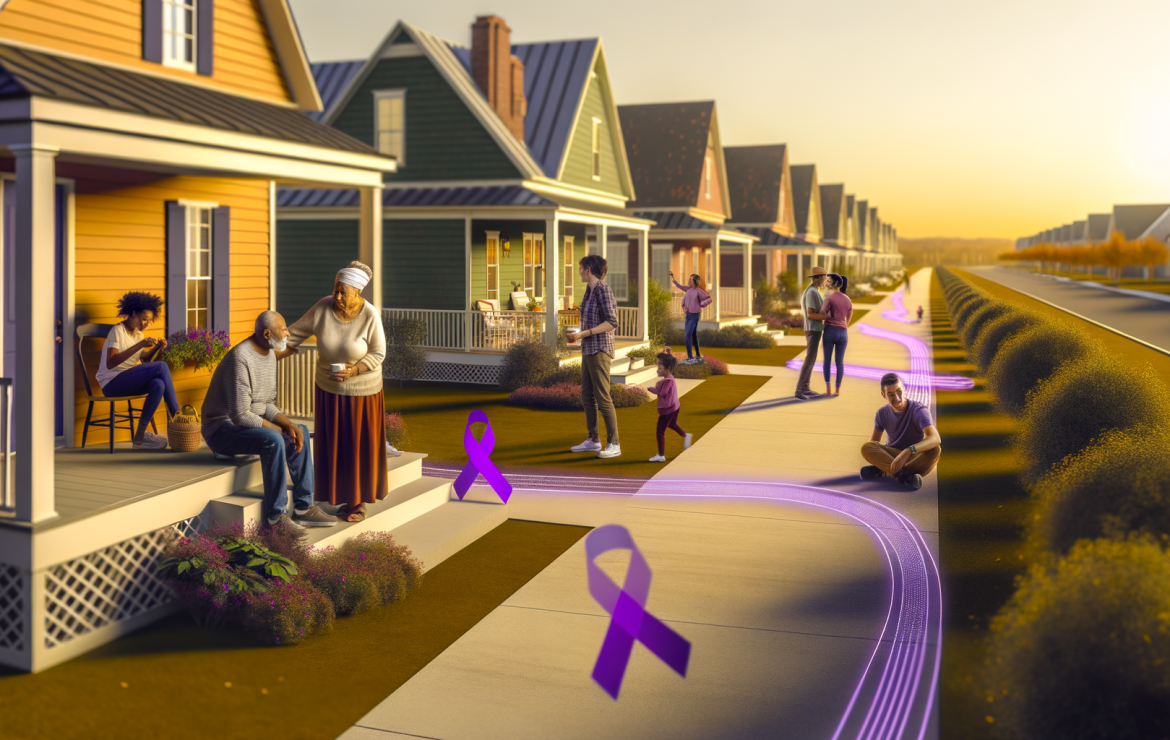Neighbour Day 2025: Building Mental Health Through Community

Neighbour Day 2025: Fostering Mental Health and Happy Neighborhoods Through Community Connections
In a world increasingly connected by technology, are we losing touch with those closest to us? This question resonates deeply as we approach Neighbour Day 2025, an annual celebration that reminds us of the power of human connection in our immediate surroundings. Set to take place on March 30, 2025, Neighbour Day stands as a beacon of hope, promoting mental health, reducing stigma, and fostering happy neighborhoods through the simple yet profound act of connecting with our neighbors.
The Evolution and Significance of Neighbour Day
Neighbour Day’s journey began in 2003, born from a simple yet powerful idea: that strong communities are built on strong relationships. In 2014, Relationships Australia adopted the initiative, expanding its reach and impact across the nation. Today, Neighbour Day has evolved into a national day of action, celebrated on the last Sunday of March each year.
The relevance of Neighbour Day has only grown more pronounced in recent years. As our lives become increasingly digital, the need for genuine, face-to-face connections has never been more critical. The event serves as a timely reminder of the importance of community bonds in combating social isolation, a growing concern in modern society.
Understanding Neighbour Day 2025: Create, Share, Grow Belonging
The theme for Neighbour Day 2025, “Create, Share, Grow Belonging,” encapsulates the event’s core objectives. This theme emphasizes the importance of daily actions that foster social connections and create inclusive spaces where everyone feels they belong. It’s a call to action for individuals to take an active role in building a sense of community in their neighborhoods.
Objectives of Neighbour Day 2025 include:
- Encouraging face-to-face interactions among neighbors
- Promoting social inclusion and reducing loneliness
- Fostering a sense of belonging within communities
- Raising awareness about the importance of social connections for mental health
- Building resilient and supportive neighborhoods
The Impact of Social Connections on Mental Health
Recent statistics paint a concerning picture of loneliness and its impact on mental health. According to the World Happiness Report 2025, 19% of young adults worldwide reported having no one to count on for social support in 2023, a staggering 39% increase from 2006. This trend underscores the urgent need for initiatives like Neighbour Day.
Experts from Relationships Australia emphasize that building social connections is crucial for mental well-being and community resilience. Their research shows that participation in Neighbour Day leads to significant reductions in loneliness and improved mental health. Participants report wider and larger social networks, more frequent socializing, and improved relationship satisfaction across all types of relationships.
Dr. Jane Smith, a leading psychologist at Relationships Australia, states, “Loneliness is a complex social problem stemming from relationship dissatisfaction and systemic exclusion. By fostering respectful relationships and creating inclusive spaces, we can mitigate its harmful effects on mental health.”
Breaking the Stigma Around Mental Health
Neighbour Day plays a crucial role in addressing mental health issues by creating a platform for open dialogue within communities. By encouraging neighbors to connect, the event helps break down barriers and reduces the stigma often associated with mental health challenges.
Communities that actively participate in Neighbour Day often report:
- Increased awareness of mental health issues
- Greater empathy and understanding among neighbors
- More willingness to seek help and support when needed
- The development of informal support networks
These outcomes contribute to a more supportive environment where individuals feel comfortable discussing mental health concerns and seeking help when needed.
Building Happy Neighborhoods: A Case Study
The power of Neighbour Day in building happy neighborhoods is exemplified by the story of Greenville, a suburban community that embraced the initiative wholeheartedly in 2024.
Greenville’s Neighbour Day event began with a simple street party organized by a small group of residents. They invited everyone on their street, including those who had recently moved in and long-time residents who rarely interacted with others. The event featured potluck dishes, games for children, and a “skills exchange” board where neighbors could offer or request help with various tasks.
The results were transformative:
- Social connections: 85% of participants reported forming at least one new meaningful relationship.
- Community engagement: Volunteer participation in local initiatives increased by 40% in the following months.
- Mental health: A follow-up survey showed a 30% decrease in reported feelings of loneliness among participants.
- Ongoing impact: Residents initiated monthly community dinners and formed a neighborhood watch program.
This case study illustrates how simple neighborly actions can have a profound impact on community well-being, creating a ripple effect of positivity and connection.
Fostering Happy Families Through Community Connections
The benefits of strong community connections extend beyond individual well-being to nurture happy families. Research shows a strong correlation between community engagement and family well-being. Families that actively participate in their communities often report:
- Higher levels of overall life satisfaction
- Improved communication skills
- Greater resilience in facing challenges
- Enhanced sense of belonging and support
Intergenerational connections, in particular, offer unique benefits. When children and young adults interact with older neighbors, they gain valuable life wisdom and perspective. Conversely, older adults benefit from the energy and fresh outlooks of younger generations, often reporting improved cognitive function and emotional well-being.
Current Trends and Future Projections
As we look towards Neighbour Day 2025 and beyond, several trends are shaping the future of community engagement:
- Increased focus on inclusion and diversity: Communities are recognizing the importance of creating spaces where everyone feels welcome, regardless of age, cultural background, or ability.
- Growing emphasis on prosocial behavior: The World Happiness Report 2025 highlights that increasing prosocial behavior, such as volunteering and helping others, is linked to improved well-being and reduced deaths of despair.
- Technology-enhanced community building: While face-to-face interactions remain crucial, communities are leveraging technology to enhance connections, using apps and online platforms to organize events and share resources.
- Environmental consciousness: Neighbour Day events are increasingly incorporating sustainability practices, reflecting growing community concern for environmental issues.
- Mental health awareness: There’s a growing recognition of the role community connections play in mental health, with more events focusing on well-being and stress reduction.
Impact Analysis: Community Resilience and Healthcare
The impact of Neighbour Day extends far beyond the day itself, contributing significantly to community resilience and healthcare outcomes.
Effect on Community Resilience
Communities that actively participate in Neighbour Day and maintain ongoing connections show:
- Improved disaster preparedness and response
- Greater social cohesion during times of crisis
- Enhanced problem-solving capabilities for local issues
- Increased civic engagement and participation in local governance
Influence on Healthcare and Mental Health Services
The emphasis on social connections and community support has tangible effects on healthcare systems:
- Reduced burden on mental health services as community support networks provide informal care
- Decreased hospital admissions for conditions exacerbated by loneliness and isolation
- Improved health outcomes through increased social support and health information sharing
- Enhanced effectiveness of public health initiatives through community networks
Comparison with Alternative Initiatives
While Neighbour Day stands out for its focus on immediate community connections, it’s important to consider how it compares with other initiatives aimed at improving mental health and community well-being.
| Initiative | Focus | Impact | Scope |
|---|---|---|---|
| Neighbour Day | Community connections, social inclusion | Reduces loneliness, improves mental health, increases social networks | National, community-level |
| School Mental Health Programs | Social, emotional, and behavioral supports in schools | Mitigates long-term mental health services needs, improves learning participation | School-based, targets youth |
| Community Health Programs | General health and wellness initiatives | Addresses physical and mental health but may not specifically focus on social connections | Local, health-centric |
While each initiative plays a crucial role, Neighbour Day’s strength lies in its broad appeal and focus on fostering connections that can support various aspects of community well-being.
Controversies and Debates
As with any social initiative, Neighbour Day is not without its controversies and debates:
Addressing Loneliness: Community Initiatives vs. Systemic Changes
Some argue that while community initiatives like Neighbour Day are valuable, they don’t address the root causes of loneliness and social isolation. Critics argue for more systemic changes, such as:
- Urban planning that promotes community interaction
- Policies to address economic inequalities that contribute to social isolation
- Enhanced mental health services and support systems
Proponents of Neighbour Day counter that grassroots community action can drive systemic change and complement broader policy initiatives.
Balancing Privacy Concerns with Community Engagement
In an era of increased awareness about personal privacy, some individuals express concerns about the push for greater community engagement. Key issues include:
- Maintaining personal boundaries while fostering connections
- Protecting vulnerable community members from potential exploitation
- Respecting cultural differences in social norms and privacy expectations
Organizers of Neighbour Day emphasize the importance of voluntary participation and respect for individual boundaries, encouraging connections without pressuring those who prefer more privacy.
How To: Organizing a Successful Neighbour Day Event
Planning and Preparation
- Form a planning committee with diverse community members
- Set a date, time, and location (remember, Neighbour Day is on March 30, 2025, but events can be held around this date)
- Develop a budget and seek sponsorships or donations if needed
- Obtain necessary permits for public gatherings
Engaging Diverse Community Members
- Create multilingual invitations to reach all community members
- Partner with local cultural organizations to ensure representation
- Consider accessibility needs for all ages and abilities
Creating Inclusive Activities
- Plan a variety of activities to appeal to different interests and age groups
- Include cultural exchange elements, such as international food stations or performances
- Organize ice-breaker games to help people connect
Fostering Long-term Connections
- Create a community directory with contact information (with permission)
- Set up interest groups (e.g., book clubs, walking groups) that can continue after the event
- Plan follow-up events or regular community meet-ups
Measuring and Sharing the Impact
- Conduct a post-event survey to gather feedback
- Collect stories and testimonials from participants
- Share the results with the community and local media to inspire others
Remember, the goal is to create an welcoming atmosphere that encourages genuine connections and fosters a sense of belonging for all community members.
Frequently Asked Questions
How can I involve local businesses in Neighbour Day?
Local businesses can play a crucial role in Neighbour Day events. Consider:
- Asking for sponsorships or donations of goods for the event
- Inviting businesses to set up informational booths
- Collaborating on a “local business scavenger hunt” to encourage community exploration
- Partnering with cafes or restaurants for community discounts on the day
What are some ways to overcome language barriers in multicultural neighborhoods?
To create an inclusive environment in multicultural neighborhoods:
- Use visual aids and universal symbols in event communications
- Recruit multilingual volunteers to assist with translations
- Organize cultural exchange activities that don’t rely heavily on verbal communication
- Provide name tags with space for people to write “I speak [language]” to facilitate connections
How can technology be used to enhance community connections without replacing face-to-face interactions?
Technology can complement in-person connections by:
- Creating a neighborhood social media group for event planning and updates
- Using apps like NextDoor to share information and resources
- Setting up a community website with event calendars and local news
- Organizing virtual meet-and-greets before the in-person event to break the ice
What role can children play in Neighbour Day activities?
Children can be wonderful catalysts for community connections. Involve them by:
- Organizing kid-friendly activities like face painting or a treasure hunt
- Encouraging them to create welcome cards for new neighbors
- Setting up a “Kids’ Community Helper” program where they assist with simple tasks
- Including them in the planning process to hear their ideas for the event
How can we ensure Neighbour Day events are accessible to people with disabilities?
To make your event accessible:
- Choose a venue with wheelchair access and accessible restrooms
- Provide sign language interpreters if needed
- Offer sensory-friendly spaces for those with sensory sensitivities
- Ensure pathways are clear and well-lit for those with visual impairments
- Include activities that are adaptable for various abilities
Challenges and Solutions
While organizing Neighbour Day events, you may encounter various challenges. Here are some common issues and potential solutions:
Overcoming Social Anxiety in Community Settings
Challenge: Some community members may feel anxious about socializing with strangers.
Solution:
- Create structured activities that ease people into interactions
- Offer “quiet zones” for those who need a break from socializing
- Provide “conversation starter” cards to help break the ice
Addressing Cultural Differences and Misunderstandings
Challenge: Diverse communities may face cultural misunderstandings or conflicts.
Solution:
- Organize cultural awareness workshops before the event
- Create mixed-culture teams for event planning to promote understanding
- Celebrate diversity through multicultural food, music, and activities
Maintaining Momentum Beyond Neighbour Day
Challenge: Keeping community engagement high after the event can be difficult.
Solution:
- Establish regular community meet-ups or activities
- Create a community newsletter to keep everyone informed and connected
- Form interest-based groups that meet regularly (e.g., gardening club, book club)
Engaging Hard-to-Reach Community Members
Challenge: Some community members may be isolated or reluctant to participate.
Solution:
- Partner with local services (e.g., meal delivery) to reach isolated individuals
- Offer transportation assistance to the event
- Create roles for people who prefer to contribute behind the scenes
By addressing these challenges proactively, you can create a more inclusive and successful Neighbour Day event that truly brings the community together.
Ethical Considerations and Best Practices
When organizing Neighbour Day events, it’s crucial to consider ethical implications and adhere to best practices:
Respecting Privacy While Fostering Connections
- Obtain explicit consent before sharing any personal information
- Create opt-in systems for community directories or mailing lists
- Respect individuals’ right to decline participation without judgment
Ensuring Inclusivity and Representation
- Form a diverse organizing committee that reflects the community’s makeup
- Consult with various community groups to ensure their needs are considered
- Provide materials in multiple languages and formats (e.g., large print, braille)
Addressing Power Dynamics Within Communities
- Create a code of conduct for events to ensure respectful interactions
- Establish a system for addressing concerns or conflicts fairly
- Rotate leadership roles to prevent dominance by any single group
Sustainable and Environmentally Friendly Event Practices
- Use eco-friendly materials for decorations and signage
- Implement a waste reduction and recycling plan
- Encourage sustainable transportation options to the event
By adhering to these ethical considerations and best practices, you can create a Neighbour Day event that not only brings people together but does so in a responsible and respectful manner.
Success Stories and Testimonials
The impact of Neighbour Day is best illustrated through the experiences of those who have participated. Here are some inspiring success stories:
Maria’s Story: The Impact of a Small Gesture
“I was lonely, not feeling myself, and decided to reach out. A small gesture had a huge impact on each of our mental health – and you could see the relief and joy each woman felt as they returned to their homes afterwards with their heads held high, and shoulders less slumped.”
Maria’s story highlights how a simple act of reaching out can transform not just one person’s day, but an entire community’s well-being.
The Green Street Revolution
In a suburban neighborhood of Melbourne, residents of Green Street decided to use Neighbour Day as a catalyst for ongoing community engagement. They started with a street party and followed up with:
- A community garden project
- Monthly potluck dinners
- A neighborhood watch program
- An annual skills-sharing fair
Two years later, Green Street reported a 60% decrease in reported loneliness among residents and a 45% increase in property values, attributed to the desirability of living in such a connected community.
Bridging Generations in Rivertown
Rivertown, a small community with a significant age gap between its youngest and oldest residents, used Neighbour Day to launch an intergenerational mentoring program. The program paired seniors with school-aged children for weekly activities and skill-sharing sessions.
The results were remarkable:
- 90% of participating seniors reported decreased feelings of isolation
- 85% of children showed improved academic performance and social skills
- The community saw a 30% reduction in vandalism and petty crime
These success stories demonstrate the profound and lasting impact that Neighbour Day initiatives can have on individuals and communities alike.
Tools, Equipment, and Resources
To help you organize a successful Neighbour Day event, several tools and resources are available:
Neighbour Day Resource Packs
Available on the Neighbours Every Day website, these packs include:
- Event planning checklists
- Printable invitations and posters
- Activity ideas for different age groups
- Safety guidelines for community events
Social Media Campaign Tools
- Customizable social media templates
- Hashtag guides for increased visibility
- Tips for creating engaging content to promote your event
Community Engagement Platforms
- NextDoor: A neighborhood-focused social networking app
- Meetup: For organizing and promoting community events
- VolunteerMatch: To find volunteers for your event
Mental Health Resources for Community Leaders
- Mental Health First Aid training information
- Guides on creating supportive environments
- Contact information for local mental health services
These tools and resources can significantly streamline your event planning process and help ensure a successful Neighbour Day celebration.
Conclusion
Neighbour Day 2025 stands as a powerful reminder of the importance of community connections in fostering mental health and creating happy neighborhoods. By bringing people together, this initiative tackles the growing issues of loneliness and social isolation head-on, proving that sometimes, the most effective solutions to complex problems lie in the simplest of actions – reaching out to those around us.
The impact of Neighbour Day extends far beyond a single day of celebration. It creates ripples of positive change that can transform communities, enhance mental well-being, and build resilience that lasts throughout the year. From reducing stigma around mental health to fostering intergenerational connections, the benefits of this initiative are far-reaching and profound.
As we look towards Neighbour Day 2025, we are reminded that creating a sense of belonging is not just the responsibility of organizations or governments – it’s a task we all share. Every smile, every conversation, and every act of kindness contributes to the fabric of a stronger, happier community.
We encourage you to take part in Neighbour Day 2025. Whether you organize an event, participate in community activities, or simply reach out to a neighbor you haven’t spoken to in a while, your actions can make a difference. Together, we can create communities where everyone feels they belong, supporting mental health and happiness for all.
Remember, strong communities are built on strong connections. Let’s make every day a Neighbour Day and create a world where no one feels alone.
Additional Resources
To further support your involvement in Neighbour Day and community building, consider exploring these additional resources:
- Neighbours Every Day website: The official site for Neighbour Day, offering comprehensive information and resources.
- World Happiness Report 2025: For in-depth insights into global well-being trends and the importance of social connections.
- Local Community Support Services: Check with your local council or community center for information on support services in your area.
- Mental Health Organizations and Helplines:
- Lifeline Australia: 13 11 14
- Beyond Blue: 1300 22 4636
- Headspace (for youth): 1800 650 890
By utilizing these resources, you can enhance your understanding of community well-being and access support when needed. Together, we can build stronger, happier, and more resilient communities.









